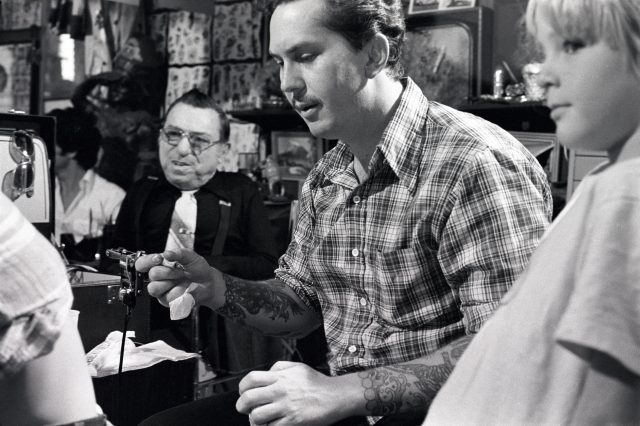
Ink legends Stoney St. Clair and Ed Hardy show how it’s done in Columbus, Ohio, in 1980 in Alan Govenar’s Tattoo Uprising (photograph by Alan Govenar / courtesy of Documentary Arts)
TATTOO UPRISING (Alan Govenar, 2019)
Cinema Village
22 East 12th St. between University Pl. & Fifth Ave.
Opens Friday, September 13
212-529-6799
www.tattoouprising.com
www.cinemavillage.com
 “Just the way they say you are what you eat, you are what you wear, too,” Calamity Jane Nemhauser says in Tattoo Uprising, Alan Govenar’s forty-years-in-the-making documentary celebrating the art of inking human bodies. Writer-director Govenar has been working on the film since 1980, when he was finishing his 1981 half hour Stoney Knows How, about tattoo legend Stoney St. Clair. Govenar and editor Jason Johnson-Spinos interweave four decades of interviews and archival footage into the film, in which Govenar speaks extensively with St. Clair and fashionista Ed Hardy, who redefined what tattooing could be; documentarian Les Blank and director Werner Herzog, who show off their tats while the former is making Burden of Dreams and the latter Fitzcarraldo; woman tattoo artists Cynthia Witkin, Calamity Jane, Jamie Summers, and Anne de Hey!; sideshow performer and tattoo artist Captain Don, who sings a song about his chosen profession; and prisoners who reveal their tattoos and discuss the impact they have on their feelings of freedom.
“Just the way they say you are what you eat, you are what you wear, too,” Calamity Jane Nemhauser says in Tattoo Uprising, Alan Govenar’s forty-years-in-the-making documentary celebrating the art of inking human bodies. Writer-director Govenar has been working on the film since 1980, when he was finishing his 1981 half hour Stoney Knows How, about tattoo legend Stoney St. Clair. Govenar and editor Jason Johnson-Spinos interweave four decades of interviews and archival footage into the film, in which Govenar speaks extensively with St. Clair and fashionista Ed Hardy, who redefined what tattooing could be; documentarian Les Blank and director Werner Herzog, who show off their tats while the former is making Burden of Dreams and the latter Fitzcarraldo; woman tattoo artists Cynthia Witkin, Calamity Jane, Jamie Summers, and Anne de Hey!; sideshow performer and tattoo artist Captain Don, who sings a song about his chosen profession; and prisoners who reveal their tattoos and discuss the impact they have on their feelings of freedom.
Author Govenar also delves into the history of tattooing, from biblical times through the Renaissance, from Captain James Cook’s discoveries to Gus Wagner’s influential flash tattoos, and such art exhibitions as “Flash from the Past: Classic American Tattoo Designs 1890 – 1965” at the Hertzberg Circus Collection and Museum in San Antonio and “Pierced Hearts and True Love: A Century of Drawings for Tattoos” at the Drawing Center in New York. “It’s a hot language. It’s a cellular semiotics of communication that we’re only now beginning to realize exists across the world and throughout history in a way that no other medium functions,” Hardy explains. And there’s plenty of tattooing, the camera getting up close and personal as needles buzz into flesh, creating complicated, daring, and exquisite designs, using the human body as a living canvas.